Young talents get younger and jounger
 Child prodigies are a well-known phenomenon in chess, which is one of the few sports or intellectual activities where children can compete with adults on equal ground (another is computer games). The great Capablanca learned the game at four, and was one of the strongest players in Cuba in his early teens.
Child prodigies are a well-known phenomenon in chess, which is one of the few sports or intellectual activities where children can compete with adults on equal ground (another is computer games). The great Capablanca learned the game at four, and was one of the strongest players in Cuba in his early teens.
In the picture at right you see the four-year-old José Raúl playing against his father, José María Capablanca Fernández, soon after learning the moves in 1892.
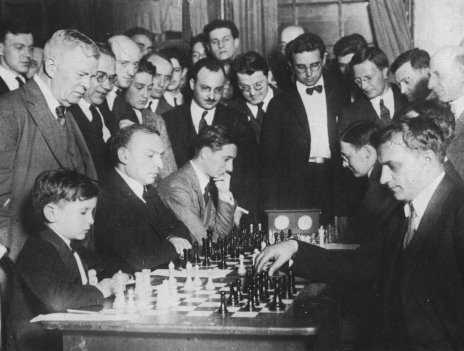
Samuel Reshevsky also started at four and was giving simultaneous exhibitions at six. He played thousands of exhibition games in the USA throughout his childhood. From the age of eight, he gave simuls around the world.
In the picture at left you see Sammy Reshevsky playing Charles Jaffe at 11. He tied for third with Janowski, Bigelow and Bernstein.
Youngest grandmasters
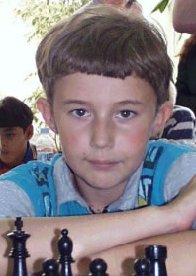 In more recent times we have seen the record for youngest grandmaster in the history of the game topple repeatedly. In 1991 Judit Polgar broke Bobby Fischer's 33-year-old mark by becoming a grandmaster a month earlier than he had done. In 1994 her record was broken by fellow-Hungarian Peter Leko, who a short time later was overtaken by Ukrainian Ruslan Ponomariov. The latter went on to become FIDE World Champion in the 2002 knockout tournament. In 2001, 14-year-old prodigy Teimour Radjabov, who hails from the same town as Garry Kasparov (Baku), became the second-youngest grandmaster in history.
In more recent times we have seen the record for youngest grandmaster in the history of the game topple repeatedly. In 1991 Judit Polgar broke Bobby Fischer's 33-year-old mark by becoming a grandmaster a month earlier than he had done. In 1994 her record was broken by fellow-Hungarian Peter Leko, who a short time later was overtaken by Ukrainian Ruslan Ponomariov. The latter went on to become FIDE World Champion in the 2002 knockout tournament. In 2001, 14-year-old prodigy Teimour Radjabov, who hails from the same town as Garry Kasparov (Baku), became the second-youngest grandmaster in history.
But all these records were shattered on August 12, 2002, when Sergey Karjakin (pictured) of Ukraine fulfilled his final grandmaster norm at the age of 12 years and seven months (4595 days). He did so at the international chess tournament in Sudak, a town on the Crimea Peninsula. His FIDE rating at the time was 2523. In the same year, Karjakin became one of the seconds of Ponomariov. This was another record he achieved before he had reached his teens.
 One extraordinary chess prodigy came close. In 2004 Magnus Carlsen of Norway, who is nine months younger than Karjakin, completed his GM norms eight months later than his rival had done.
One extraordinary chess prodigy came close. In 2004 Magnus Carlsen of Norway, who is nine months younger than Karjakin, completed his GM norms eight months later than his rival had done.
Carlsen, who at 18 trained for a while with Kasparov, went on to become the top-ranked player in the world, crossing the magic 2800 mark as the youngest player by far to achieve both these feats.
Since Carlsen, five other players even younger have successfully achieved the qualifications for the GM title.
In 2018, when we last updated our list of youngest grandmaster, we wrote "Although we must be cautious with such statements one must assume that Karjakin's records will not be broken." It almost was, when Dommaraju Gukesh from India scored his final GM-norm 19 days later than Karjakin.
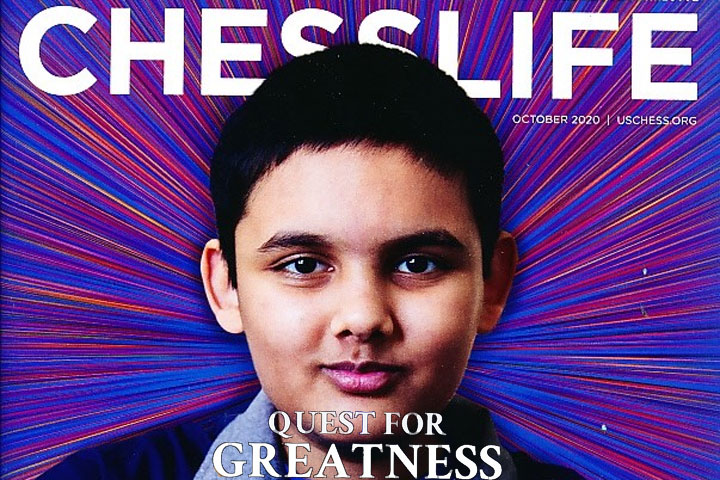
Finally a remarkable young lad from Englishtown, scored his third and final GM norm at the age of 12 years, 4 months, and 25 days, which was 66 days sooner than Sergey Karjakin. In the meantime Abhi has written a book about the adventure of becoming the youngest grandmaster in the history of the game.
Now the time has come to update our list the youngest grandmasters in history. We have done our best to compile an accurate record, but would welcom feedback from our readers, who can supply additional data or make corrections to our list.
Youngest grandmasters in history
Top Juniors
Apart from the age at which they became grandmasters we are also interested in the question or how strong the juniors were at different ages. Garrett Kingman, who is an undergraduate at Harvard University studying and regenerative biology, prepared the following illuminating graph for us:
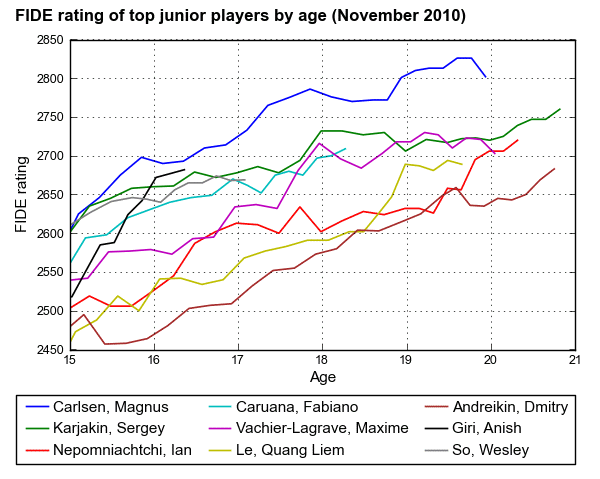
Young GM rating progress before the age of 21
As we can see Magnus Carlsen was the highest ever rated starting from the age of fifteen. Anish Giri is the second-strongest sixteen-year-old in history, Sergey Karjakin the third strongest. From then on it is Karjakin, Maxime Vachier-Lagrave and Fabiano Caruana battling for the rank of second, third and fourth strongest 17- and 18-year-olds.
FIDE rating of top players by age (July 2018)
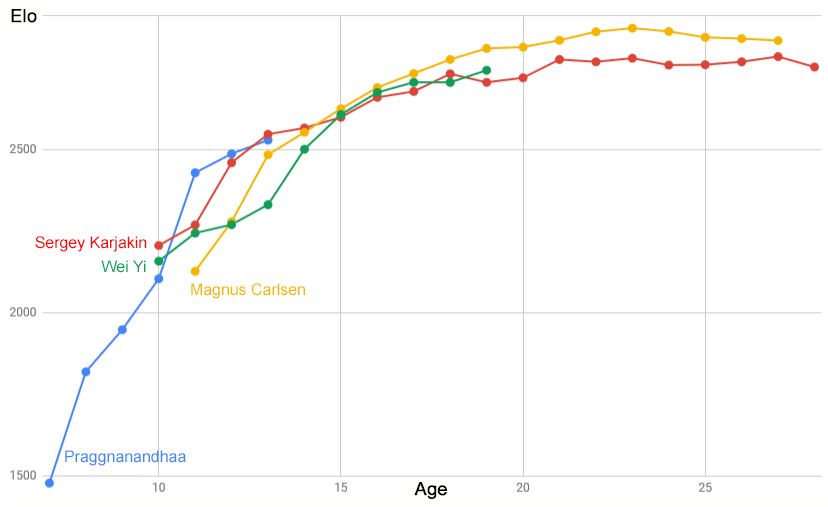
Comparison of recent young prodigies ratings progression
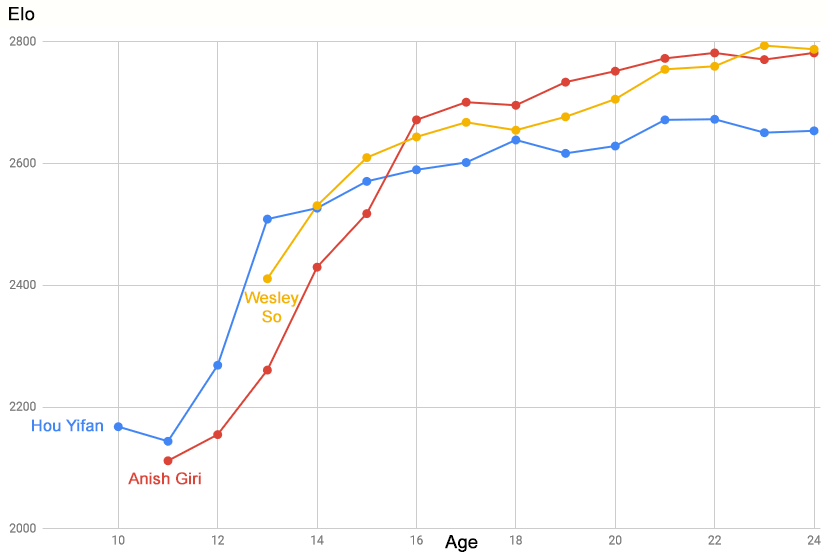
Ratings progression of So, Giri and Hou Yifan
Former women's world champion Hou Yifan was better than Anish Giri and Wesley So at the age of thirteen, but the two male players caught up and moved into the Elo stratosphere. It is worth mentioning that Judit Polgar was rated a whopping 2555 at the age of twelve, after her unbelievable 2694 performance at the Olympiad. We also believe that she was the youngest top 100 player in history.
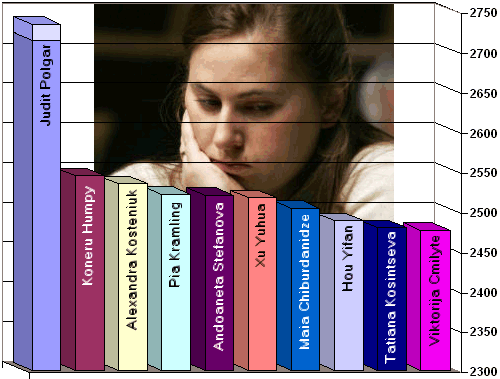
Judit Polgar's dominance of women's chess back in 2006
Other famous chess prodigies and records
Here are a few other names, facts and records of interest:
-
Paul Morphy, 1837-1884, beat Johann Löwenthal 3-0 at age 12
-
José Raúl Capablanca, 1888-1942, learned chess at the age of four, beat his country's chess champion in a match when he was 13, and eventually became world champion (see above).
-
Samuel Reshevsky learned the rules at the age of 4 and gave simultaneous exhibitions at the age of six
-
Arturo Pomar played in the Spanish Championship at age 10 and became a master at age 13. He drew Alekhine in Gijon in 1944 at the age of 13.
-
Boris Spassky became an International Grandmaster at 18 and went on to become world champion.
-
Bobby Fischer became US Champion at the age of 14 and a world championship candidate at 15. He went on to become world champion.
-
Henrique Mecking of Brazil learned the game at 6, gave some simultaneous displays at 9, won the Brazilian championship at 13, and South American Zonal at 14, and became an IM at 15. He won two Interzonal Tournaments in a row, at 21 and 24.
-
Anatoly Karpov became a grandmaster at 18 and went on to become world champion.
-
Garry Kasparov became a grandmaster at 17 and went on to become the youngest ever world champion (at 22).
-
Nigel Short finished joint first in the British Championship at the age of 14.
-
Viswanathan Anand became India's first International Grandmaster at 18.
-
Michael Adams became an International Master at 15 and a grandmaster at 17.
-
Pentala Harikrishna was India's youngest grandmaster when he earned the title at 15.
-
Gata Kamsky had an Elo rating of 2650 at the age of 16.
-
Luke McShane won the World Under-10 Championship at the age of eight.
-
Ruslan Ponomariov became the youngest ever FIDE knockout world champion at the age of 18.
-
Alejandro Ramirez became a grandmaster at 15, a month earlier than Fischer. He was the first grandmaster ever in Central America.
-
Magnus Carlsen became the second-youngest grandmaster in history at 13, and broke Fischer's record by becoming a world championship candidate at 15 years and one month.
-
Parimarjan Negi has achieved five IM norms and one GM norm by the age of twelve and surpassed Magnus Carlsen as the youngest GM in the world in 2006.
-
Mona Khaled achieved the WIM title and two WGM norms in 2005, when she was eleven years old. At the same time, she won both the Arabian and the African Girls Junior Championship in the under 20 group in 2005, although she was the youngest player in both tournaments.
-
In January 2007 David Howell became the youngest grandmaster in UK history, at sixteen years and one month, breaking Luke McShane's previous record set in 2000 by six months.
-
On December 7th 2007 Wesley So of the Philippines made his final grandmaster norm at the age of 14 years, one month and 28 days to become the seventh-youngest GM in history.
-
In 2008 Hou Yifan, born February 27, 1994, in Xinghua, China, became the youngest ever female in history (at the age of 14 years 6 months 2 days) to qualify for the title of grandmaster.
-
Judit Polgar earned her GM title at age 15 years and five months, but was already clearly of GM strength at 12. At the 1988 Olympiad she scored 12½/13 for the Hungarian team, with a 2692 performance. Judit was the youngest player to ever rank amongst the world's top 100, at the age of 12, with a rating of 2555 in 57th place.
-
At the Wijk aan Zee tournament on January 30, 2009 the Russian/Nepalese/Dutch player Anish Giri, born on June 28, 1994, completed his third and final GM norm, at the age of 14 years, 7 months and 2 days.
-
In October 2009 Ray Robson made his final GM norm, becoming the youngest US player ever to achieve this. He was 14 years, 11 months and 16 days old at the time. Ray was formally awarded the title in January 2010.
-
In April 2009 Dariusz Swiercz (born 31 May 1994), became a grandmaster, just days before his fifteenth birthday.
-
In March 2010 Hungarian prodigy Richard Rapport made his final GM norm at the Gotth' Art Cup, three weeks before his fourteenth birthday.
-
On December 29th 2010, three months after his 14th birthday, Ukrainian prodigy Illya Nyzhnyk drew his penultimate game at the Schaakfestival Open in Groningen to complete his final GM norm. His performance in the whole event was 2670.
-
Suri Vaibhav, born 8 Feb 1997, became India’s latest grandmaster when he won the Luc Open in Lille, France on April 29, 2012.
-
On February 25, 2013, Chinese IM Wei Yi completed his third and final GM norm at the Reykjavik Open at the age of 13 years 8 months and 23 days. This made him the fourth-youngest grandmaster in history at that time (after Karjakin, Negi and Carlsen).
-
In November 2014, Samuel Sevian set a record as the youngest US grandmaster after winning the Saint Louis GM-norm Invitational and raising his FIDE rating above 2500, at the age of 13 years, 10 months, and 27 days.
Thanks to James Satrapa of Canberra, Australia, provided us with the data of additional players we had missed in an earlier update. All were duly added to our 2018 list. As mentioned above, we welcome additions and corrections by our readers.
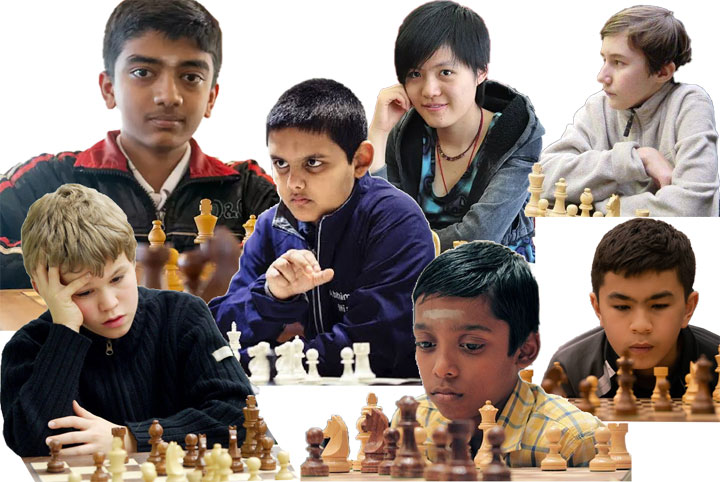

















 Child prodigies are a well-known phenomenon in chess, which is one of the few sports or intellectual activities where children can compete with adults on equal ground (another is
Child prodigies are a well-known phenomenon in chess, which is one of the few sports or intellectual activities where children can compete with adults on equal ground (another is 
 In more recent times we have seen the record for youngest grandmaster in the history of the game topple repeatedly. In 1991 Judit Polgar broke Bobby Fischer's 33-year-old mark by becoming a grandmaster a month earlier than he had done. In 1994 her record was broken by fellow-Hungarian Peter Leko, who a short time later was overtaken by Ukrainian Ruslan Ponomariov. The latter went on to become FIDE World Champion in the 2002 knockout tournament. In 2001, 14-year-old prodigy Teimour Radjabov, who hails from the same town as Garry Kasparov (Baku), became the second-youngest grandmaster in history.
In more recent times we have seen the record for youngest grandmaster in the history of the game topple repeatedly. In 1991 Judit Polgar broke Bobby Fischer's 33-year-old mark by becoming a grandmaster a month earlier than he had done. In 1994 her record was broken by fellow-Hungarian Peter Leko, who a short time later was overtaken by Ukrainian Ruslan Ponomariov. The latter went on to become FIDE World Champion in the 2002 knockout tournament. In 2001, 14-year-old prodigy Teimour Radjabov, who hails from the same town as Garry Kasparov (Baku), became the second-youngest grandmaster in history. One extraordinary chess prodigy came close. In 2004 Magnus Carlsen of Norway, who is nine months younger than Karjakin, completed his GM norms eight months later than his rival had done.
One extraordinary chess prodigy came close. In 2004 Magnus Carlsen of Norway, who is nine months younger than Karjakin, completed his GM norms eight months later than his rival had done.









